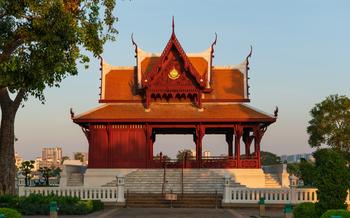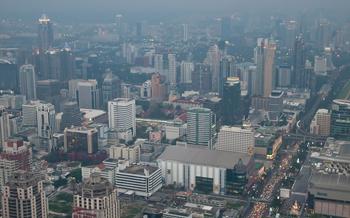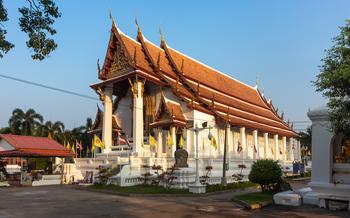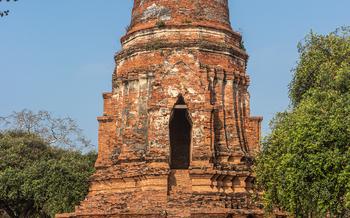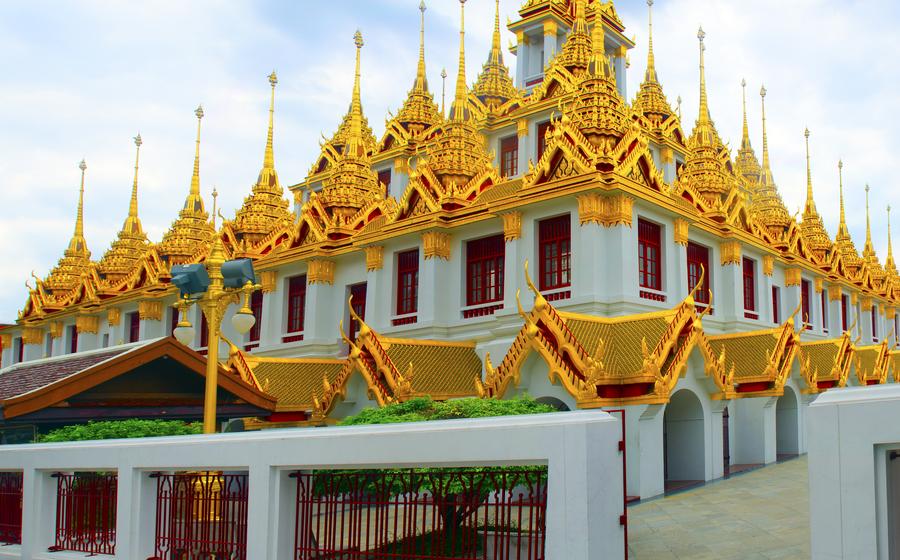
Wat Ratchanatdaram and Loha Prasat
- A Temple of Stunning Beauty: Wat Ratchanatdaram
- Paying Homage at the Loha Prasat
- Historical Background and Origins
- Symbolic Significance and Religious Importance
- Architectural Features and Design Elements
- Exploring the Temple Grounds: Wat Ratchanatdaram
- Unveiling the History of Wat Ratchanatdaram
- Unraveling the Legends of the Loha Prasat
- Immerse in the Local Culture
- Timing Your Visit
- Dress Code and Etiquette
- Unforgettable Photo Opportunities
- Transportation Options
- Guided Tours and Local Guides
- Accommodation Nearby
- Solo Travel Tips for Peace and Solitude
- Timing is Key
- Embrace Solitude
- Safety Precautions
- Capture Your Journey
- Embrace the Experience
- Family-Friendly Activities
- Insider Tip: Hidden Gem
A Temple of Stunning Beauty: Wat Ratchanatdaram
Wat Ratchanatdaram, an architectural marvel nestled amidst the bustling streets of Bangkok, Thailand, stands as a testament to the country's rich cultural heritage and religious devotion. Founded in the 19th century by King Nangklao, also known as Rama III, this royal temple exudes an aura of serenity and awe. Its symmetrical design, intricate carvings, and resplendent murals reflect the finest craftsmanship of the Rattanakosin era.
The temple's striking features include the ubosot, or ordination hall, which houses an impressive collection of Buddha images and murals depicting scenes from the Jataka tales. The mondop, a square-shaped pavilion, serves as a repository for sacred scriptures and ancient artifacts. The viharn, or assembly hall, is adorned with elaborate murals portraying episodes from Buddha's life and teachings, offering visitors a glimpse into the profound teachings of Buddhism.
Wat Ratchanatdaram's spiritual significance is palpable. Monks clad in saffron robes chant sutras, creating a harmonious melody that fills the air. Devotees flock to the temple to offer prayers, light candles, and make merit, seeking blessings and guidance in their daily lives. The temple's serene atmosphere invites contemplation and introspection, providing a sanctuary for those seeking peace and solace amidst the urban chaos.
Paying Homage at the Loha Prasat
The Loha Prasat, also known as the Iron Palace or Metal Castle, is a unique and awe-inspiring structure located within the grounds of Wat Ratchanatdaram. Constructed entirely of cast iron, this remarkable edifice holds deep historical and religious significance for the Thai people.
Historical Background and Origins
The Loha Prasat was built in the early 19th century during the reign of King Rama III. It is believed that the king commissioned the construction of the metal castle as a tribute to his mother, who was a devout Buddhist and had expressed a desire to see a temple made entirely of iron.
Symbolic Significance and Religious Importance
The Loha Prasat is a symbol of strength, resilience, and devotion. Its construction from iron, a material known for its durability and resistance, represents the unshakeable faith of the Thai people in Buddhism. The metal castle is also believed to be a representation of Mount Meru, the sacred mountain in Buddhist cosmology that is said to be the dwelling place of the gods.
Architectural Features and Design Elements
The Loha Prasat is a truly remarkable architectural achievement. It consists of a central tower surrounded by four smaller towers, all of which are intricately decorated with Buddhist motifs and symbols. The use of cast iron in its construction is unique in Thai architecture, and the intricate fretwork and ornamentation that adorn the towers are a testament to the skill and craftsmanship of the artisans who built it.
Exploring the Temple Grounds: Wat Ratchanatdaram
The temple complex of Wat Ratchanatdaram is a tapestry of architectural wonders, each element contributing to its serene atmosphere. As you wander through the grounds, marvel at the intricate stupas, each adorned with exquisite carvings that tell tales of Buddhist mythology. Discover hidden shrines nestled amidst the lush greenery, where devotees seek solace and offer prayers. The serene atmosphere invites contemplation and introspection, providing a sanctuary from the bustling city outside.
Facilities for visitors have been thoughtfully incorporated into the temple grounds, ensuring a comfortable and enriching experience. Restrooms are conveniently located, allowing you to freshen up and continue your exploration. Souvenir shops offer a variety of items, from traditional handicrafts to religious artifacts, enabling you to take home a piece of this sacred space.
Unveiling the History of Wat Ratchanatdaram
Wat Ratchanatdaram, a testament to Bangkok's rich history and religious devotion, was founded in the early 19th century during the reign of King Rama III. The temple's construction was initiated by the king as a tribute to his father, King Rama II, and as a means to honor the Buddhist faith. Wat Ratchanatdaram played a pivotal role in religious ceremonies and festivals during the Rattanakosin era, serving as a venue for royal rituals, ordinations, and other significant events.
Over the years, the temple underwent several renovations and restorations, each contributing to its evolving architectural style and grandeur. The most notable renovation was conducted during the reign of King Rama V, who commissioned extensive repairs and embellishments to enhance the temple's beauty and grandeur. These renovations included the addition of intricate murals, the construction of new stupas and shrines, and the gilding of the temple's spires and roofs.
In the present day, Wat Ratchanatdaram stands as a living testament to Thailand's cultural heritage and religious devotion. The temple continues to attract visitors from around the world, who come to admire its architectural splendor, marvel at its intricate artwork, and experience the spiritual atmosphere that permeates its grounds. Efforts are ongoing to preserve and maintain the temple's historical integrity, ensuring that it remains a source of inspiration and wonder for generations to come.
Unraveling the Legends of the Loha Prasat
The Loha Prasat is deeply entwined with Thai folklore and mythology, giving rise to numerous captivating legends. One prominent legend revolves around its mythical origins, narrating the tale of a powerful king who sought to construct an indestructible castle. Through divine intervention, a magical metal alloy was created, and the castle was forged under the guidance of celestial beings.
Another legend recounts the purpose of the Loha Prasat. It is said that the metal castle served as a repository for sacred relics and treasures, including the Buddha's relics and ancient scriptures. These relics were believed to possess immense power and were guarded by celestial beings who resided within the castle.
Miracles and answered prayers are often attributed to the Loha Prasat. Devotees have recounted stories of healing, protection, and fulfillment of wishes after praying at the metal castle. The belief in its sacredness and the power of the relics within has made it a popular destination for pilgrims and worshippers seeking divine blessings.
These legends have been passed down through generations, adding to the mystique and allure of the Loha Prasat. They have shaped the cultural significance of the metal castle and continue to inspire awe and reverence among those who visit this remarkable monument.
Immerse in the Local Culture
To truly embrace the essence of your journey, immerse yourself in the vibrant local culture that surrounds these sacred sites. Participate in traditional ceremonies and festivals held at the temple, where you can witness the devotion and customs of the Thai people. Engage with the local community, strike up conversations, and learn about their way of life. Sample the delectable Thai cuisine, a symphony of flavors that will tantalize your taste buds. Explore the bustling local markets, where you can find an array of fresh produce, handicrafts, and souvenirs. Partake in cultural activities such as traditional dance performances and cooking classes, gaining a deeper understanding of Thailand's rich artistic heritage. Immerse yourself in the local culture and create memories that will last a lifetime.
Timing Your Visit
To fully appreciate the beauty and tranquility of Wat Ratchanatdaram and the Loha Prasat, it is crucial to choose the right time for your visit. The ideal period to explore these temples is during the dry season, which typically lasts from November to April. During this time, the weather is pleasant, with clear skies and low humidity, making it comfortable for outdoor exploration.
As for the time of day, the early morning hours offer the best lighting and atmosphere. The gentle sunlight casts a warm glow on the temple's intricate architecture, creating breathtaking photo opportunities. Moreover, the early morning is usually less crowded, allowing you to immerse yourself in the serene ambiance of the temples without distractions.
To avoid the crowds and ensure a peaceful experience, it is advisable to steer clear of weekends and public holidays. If possible, aim to visit the temples during the weekdays, when there are fewer visitors. This will provide you with ample time to explore the grounds at your own pace and fully absorb the spiritual atmosphere.
Dress Code and Etiquette
When visiting sacred sites like Wat Ratchanatdaram and the Loha Prasat, it is important to dress respectfully and observe proper etiquette. Visitors should wear modest clothing that covers their shoulders and knees. Shorts, tank tops, and revealing clothing are generally not appropriate. It is customary to remove your shoes before entering the temple grounds and to walk barefoot or in socks.
It is also important to be mindful of your behavior within the temples. Speaking loudly, laughing, or engaging in disruptive activities is considered disrespectful. It is customary to bow or wai (a traditional Thai gesture with hands pressed together) when entering or leaving a temple, as well as when passing in front of Buddha images.
When interacting with monks or local people, it is important to be polite and respectful. Monks are highly revered in Thai culture, and it is considered improper to touch or address them directly. When speaking to a monk, it is customary to kneel or sit on the floor.
By observing these guidelines for dress code and etiquette, visitors can show their respect for the local culture and religion, and ensure a peaceful and enjoyable experience for all.
Unforgettable Photo Opportunities
Wat Ratchanatdaram and the Loha Prasat offer a treasure trove of captivating photo opportunities that will leave you with lasting memories. Capture the stunning architecture of the temples, showcasing their intricate details and ornate embellishments. Frame the majestic Loha Prasat against the backdrop of the Bangkok skyline, creating a striking contrast between the ancient structure and the modern cityscape. Seek out unique angles and perspectives to reveal the temples' hidden beauty, experimenting with different vantage points to showcase their grandeur. Share your travel memories through captivating photographs, inspiring others to embark on their own journey of discovery and wonder.
Transportation Options
Getting to Wat Ratchanatdaram and the Loha Prasat is a breeze, with multiple transportation options available.
-
Public transportation is a reliable and affordable choice. Take the MRT (subway) to Hua Lamphong station and transfer to the Chao Phraya Express Boat. Disembark at the Ratchawong Pier and walk for about 10 minutes to reach the temples.
-
Taxis and tuk-tuks are readily available and offer a convenient door-to-door service. Simply hail one on the street or book through a ride-hailing app.
-
Joining a guided tour is an excellent option for those seeking a hassle-free experience. Tours typically include transportation to and from your hotel, as well as informative commentary from a knowledgeable guide.
Whichever mode of transport you choose, ensure you leave ample time to explore the temples thoroughly and soak in their serene atmosphere.
Guided Tours and Local Guides
Enrich your visit to Wat Ratchanatdaram and the Loha Prasat by booking a guided tour. Led by knowledgeable local guides, these tours offer a deeper understanding of the temples' history, architecture, and cultural significance. Guides can point out intricate details and hidden gems that you might miss on your own, bringing the temples' stories to life. Look for reputable tour operators that offer a variety of itineraries, catering to different interests and budget levels. Tours are typically conducted in English and other major languages, ensuring that international visitors can fully grasp the significance of these sacred sites. Prices vary depending on the tour duration, group size, and inclusions, but generally range from 500 to 2,000 Thai Baht.
Accommodation Nearby
Finding a comfortable place to stay near Wat Ratchanatdaram and the Loha Prasat is a breeze, with a variety of hotels and guesthouses to choose from. For those seeking a luxurious experience, the five-star Peninsula Bangkok is just a short walk away, offering stunning views of the Chao Phraya River. Budget-conscious travelers will find solace in the many guesthouses located within walking distance of the temples, such as the popular Rambuttri Village Plaza, which offers clean and comfortable rooms at affordable rates.
Each accommodation option provides its own unique amenities and services, catering to the diverse needs of travelers. Some hotels feature rooftop pools, fitness centers, and exquisite dining options, while guesthouses often offer a more intimate and homely atmosphere. Whether you seek luxury or affordability, there's a perfect accommodation option waiting for you near Wat Ratchanatdaram and the Loha Prasat.
Solo Travel Tips for Peace and Solitude
Navigating the bustling temples of Bangkok as a solo traveler may seem daunting, but with the right approach, you can find peace and solitude amidst the crowds. Here's how to make the most of your solo visit:
Timing is Key
Avoid peak hours and opt for early mornings or late afternoons when the temples see fewer visitors. This serene ambiance will allow you to fully immerse yourself in the spiritual atmosphere and appreciate the intricate details of the temples without the distractions of large crowds.
Embrace Solitude
Embrace the opportunity for self-reflection and spiritual contemplation that solo travel offers. Take advantage of the quiet moments to connect with your inner self and find tranquility within the sacred spaces of the temples.
Safety Precautions
As a solo traveler, prioritize your safety. Be aware of your surroundings, avoid displaying valuables, and dress respectfully to blend in with the local culture. Consider joining a guided tour if you prefer the security of a group setting.
Capture Your Journey
Document your solo adventure through photography, journaling, or sketching. Capturing the beauty of the temples and your personal reflections will create lasting memories of your journey.
Embrace the Experience
Solo travel offers a unique opportunity for personal growth and self-discovery. Embrace the chance to explore the temples at your own pace, connect with locals, and create unforgettable memories that will stay with you long after your visit.
Family-Friendly Activities
Wat Ratchanatdaram and the Loha Prasat offer a welcoming environment for families with children. The temple grounds are spacious and well-maintained, providing ample space for kids to run around and explore. Several notable features within the grounds, such as stupas, shrines, and a pond with turtles, can capture children's attention and spark their curiosity.
Families can engage in several activities to make their visit more enjoyable and educational. Guided tours tailored for families are available, offering interactive storytelling and age-appropriate explanations of the temples' history and significance. These tours can help children understand and appreciate the cultural and religious aspects of the temples.
Furthermore, families can participate in traditional Thai dance performances or cooking classes offered nearby. These activities provide a hands-on experience for children to learn about Thai culture and traditions. The vibrant colors, rhythmic movements, and delicious flavors will undoubtedly create lasting memories for the whole family.
Remember to pack snacks and drinks for your children, as there are limited food options available within the temple grounds. Plan for regular breaks to keep your kids hydrated and energized throughout the visit. With its family-friendly atmosphere and engaging activities, Wat Ratchanatdaram and the Loha Prasat promise a memorable experience for families traveling together.
Insider Tip: Hidden Gem
Venture beyond the renowned temples of Wat Ratchanatdaram and the Loha Prasat to uncover a hidden gem nestled nearby: the serene and picturesque Wat Intharawihan. This lesser-known temple boasts a unique charm and tranquility that invites you to immerse yourself in its rich history and spiritual ambiance.
Dating back to the 19th century, Wat Intharawihan exudes a palpable sense of peace and tranquility. Its well-preserved architecture showcases intricate carvings and stunning murals that depict scenes from Buddhist mythology. Admire the intricate details of the temple's ordination hall, where monks gather for daily prayers and ceremonies.
As you explore the temple grounds, take a moment to reflect on the stories and legends associated with Wat Intharawihan. Local folklore tells of a miraculous event that occurred during the temple's construction, where a Buddha image was discovered buried beneath the ground. This discovery is believed to have brought good fortune and blessings to the temple and its surrounding community.
Whether you seek a solitary retreat or a deeper connection with Thai culture, Wat Intharawihan offers a unique and rewarding experience. Embrace the opportunity to explore this hidden gem and create lasting memories of your journey through Thailand's sacred treasures.
